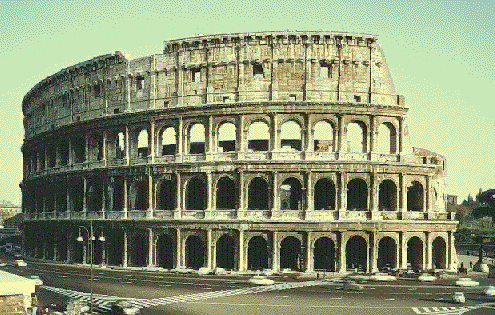The temple of Artemis at Ephesus
The Mausoleum at Halicarnassus
The Hanging Gardens of Babylon
The Porcelain Tower of Nanking
Construction of the Colosseo (Colosseum) was started by Vespasian in 72 AD in the grounds of Nero's private Domus Aurea. Originally known as the Flavian Amphitheatre, after the family name of Vespasian, it was inaugurated by his son Titus in 80 AD. The massive structure could seat more than 50,000 (the 4th century figure of 87,000 is disputed), and the bloody gladiator combat and wild beast shows held there.
The splendid games held at the inauguration of the Colosseo lasted for 100 days and nights, during which some 5,000 animals were slaughtered. Trajan once held games which lasted for 117 days, during which some 9,000 gladiators fought to the death.
With the fall of the Empire, the Colosseo was abandoned and gradually became overgrown. Exotic plants grew there for centuries; seeds bad in advertently been transported from Africa and Asia with the wild beasts that appeared in the arena (including crocodiles, bears, lions, tigers, elephants, rhinos, hippos, camels and giraffes).
In the Middle Ages the Colosseo became a fortress, occupied by two of the city's warrior families: the Frangipani and the Annibaldi. Its reputation as a symbol of Rome, the "Etemal City", also dates to the Middle Ages, with Bede writing that "while the Colosseo stands, Rome shall stand, but when the Colosseo falls, Rome shall fall and when Rome falls, the world will end".
Damaged several times by earthquake, it was later used as a quarry for travertine and marble for the Palazzo Venezia and other buildings. Pollution and the vibrations caused by traffic and the Metro have also taken their toll. Restoration works have periodically been carried out, the latest starting in 1992. Current estimates have a restored Colosseo being unveiled by 2004.
